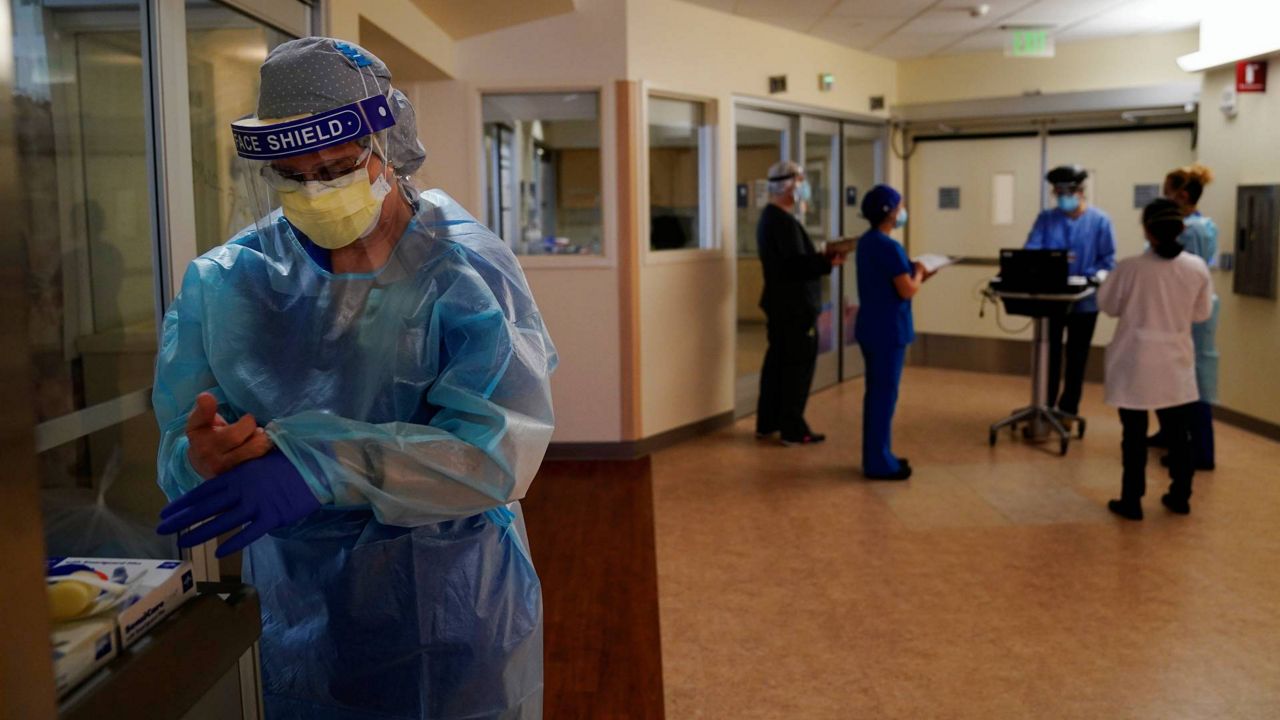SANTA ANA, Calif. (CNS) — Orange County saw a jump in COVID-19 hospitalizations Tuesday but a decrease in weekly averages for infection rates, according to data released by the Orange County Health Care Agency.
The number of hospitalized patients ticked up from 181 Monday to 196 on Tuesday, with the number of intensive care patients climbing from 43 to 52.
What You Need To Know
- Orange County saw a jump in COVID-19 hospitalizations, according to data released Tuesday
- The number of intensive care patients climbed from 43 to 52
- The county reported 222 new infections, raising the cumulative case count to 312,845
- OC also logged 15 additional fatalities Tuesday
The county had 24.7% of its ICU beds and 68% of its ventilators available.
The county's weekly COVID-19 case rate per 100,000 residents declined from 6.9 last Tuesday to 6.1 as of this week, while the rate of people testing positive for the virus ticked down from 2.7% last week to 2.4%, according to Orange County CEO Frank Kim.
The county's Health Equity Quartile positivity rate — which measures progress in low-income communities — declined from 3% last week to 2.8%.
The county also reported 222 new infections on Tuesday, raising the cumulative case count to 312,845, and logged 15 additional fatalities. The cumulative death toll now stands at 5,725.
"The numbers are stable, kind of more of the same," Andrew Noymer, an epidemiologist and UC Irvine professor of population health and disease prevention, told City News Service on Monday.
As for the new omicron variant detected in Africa, Europe and Canada, Noymer said it is "too early to tell" what effect it may have.
"I'm a little nervous they're shutting off travel, which gives the impression they know more than they're letting on. But I honestly feel that we don't know very much," he said.
Noymer said it appeared there were "some gaps in surveillance and sequencing" the new variant, so, "we don't see the precursors to omicron. We see that omicron has arrived on the scene and is very different, but we don't see its precursors. We need to step up sequencing so we don't get blindsided again."
Orange County's deputy health officer told reporters last week that although COVID-19 infection and hospitalization rates have generally been inching down, it may be the floor before an expected winter surge.
"It's obviously plateaued," Dr. Regina Chinsio-Kwong said. "I think this may be our new floor ... I'm hoping it will continue to decline, but with all the celebrations coming up and gatherings there is potential it will increase slightly, and there's a potential for a surge in January."
Of the 15 fatalities logged Tuesday, five occurred this month, raising November's death toll to 24. Nine others happened in October, raising last month's death toll to 108.
One of the fatalities occurred in September, raising that month's death toll to 188, ahead of August's death toll of 176.
In contrast, the death toll before the more contagious Delta variant- fueled summer surge was 31 in July, 19 for June, 26 for May, 46 for April, 200 for March, 615 for February.
January remains the deadliest month of the pandemic with a death toll of 1,593, ahead of December, the next deadliest at 981.
The county's case rate per 100,000 for the fully vaccinated was at 2.6 as of Nov. 20, down from 3.2 as of Nov. 13, according to the latest data available. The case rate for the unvaccinated was at 13.8, down from 16.3, during the same time period.
As of Nov. 22, 71% of the total population had received at least one dose of a COVID vaccine, and 64% were fully vaccinated, according to Chinsio- Kwong. For the population eligible for a vaccine, ages 5 and above, 75% have received at least one dose and 68% were fully vaccinated.
Among those 65 and older, 95% have received at least one dose and 88% are fully vaccinated.
In the newly eligible age group of 5 to 11, 13%, or 35,022 children, have received at least one dose.
"I think it's reassuring," Chinsio-Kwong said of vaccination rates. "But I think we can do a lot better, especially with the holidays around the corner. Our biggest risk is all of these small gatherings. I know people want to hug, laugh, eat and drink and usually when that happens in a closed environment people don't have a mask on people might have COVID and not have symptoms and transmit it to others and not know about it until three to seven days later."
Chinsio-Kwong advised testing for COVID-19 for those who travel or get together at parties.



